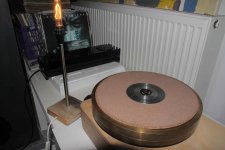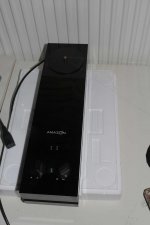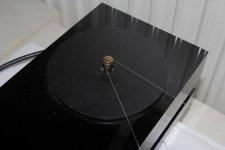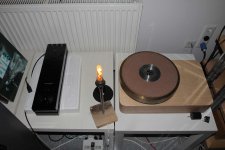The turntable is spinning !
This is really exiting.
I build my last table over 35 years ago.
Dominik has made me a bearing for the heavy brass platter plus a plinth.
Thanks Dominik ?
I know, it must have being hard for you just working with what you have at home.
The platter is going real smooth.
Frank Schröder checked it during Frickelfest.
When it stops it even runs a tiny bit back.
Frank says that is a good thing.
He also told me to use a weak motor to benefit from the energy storage the heavy platter has.
I am using a DC motor right now.
It is the motor part of an Amazon table.
I will post more information and pictures soon.
This is really exiting.
I build my last table over 35 years ago.
Dominik has made me a bearing for the heavy brass platter plus a plinth.
Thanks Dominik ?
I know, it must have being hard for you just working with what you have at home.
The platter is going real smooth.
Frank Schröder checked it during Frickelfest.
When it stops it even runs a tiny bit back.
Frank says that is a good thing.
He also told me to use a weak motor to benefit from the energy storage the heavy platter has.
I am using a DC motor right now.
It is the motor part of an Amazon table.
I will post more information and pictures soon.
Congrats ... for spinning.
Quid: What's time (minutes) for free spinning from 33,3rpm to 0 rpm ?
Let's play music.
Quid: What's time (minutes) for free spinning from 33,3rpm to 0 rpm ?
Let's play music.
Hi Joachim,
What I meant was: Since that platter has such high inertia, any "normal" high torque motor will likely not increase short term speed stability, but "feed" vibrations into platter and(depending upon the motor suspension - or motor pod arrangement) the plinth as well.
So, if a platter weighs 25kg or more, the only reason for a strong motor is to bring it up to speed quickly. If the motor in use has high torque AND is running quietly, no problem...
A platter spinning forever is not better or worse than one that breaks down quickly, as long as both are producing the same (low) noise and each is used with an appropriate motor. Many motors operate with lower vibration and lower brush noise(in case of DC motors) when they work against a defined(not maximally small) load.
Cheers,
Frank
What I meant was: Since that platter has such high inertia, any "normal" high torque motor will likely not increase short term speed stability, but "feed" vibrations into platter and(depending upon the motor suspension - or motor pod arrangement) the plinth as well.
So, if a platter weighs 25kg or more, the only reason for a strong motor is to bring it up to speed quickly. If the motor in use has high torque AND is running quietly, no problem...
A platter spinning forever is not better or worse than one that breaks down quickly, as long as both are producing the same (low) noise and each is used with an appropriate motor. Many motors operate with lower vibration and lower brush noise(in case of DC motors) when they work against a defined(not maximally small) load.
Cheers,
Frank
I understand.
So it is the noise issue.
The platter needs some time to come up to speed.
I have not stopped the time but i will.
That does not bother me.
I will keep the platter running all the time anyway.
I will now adjust the speed again.
I am using a 0.35mm filament as string.
I made a surgeon not and meltet it down as good as posible.
So it is the noise issue.
The platter needs some time to come up to speed.
I have not stopped the time but i will.
That does not bother me.
I will keep the platter running all the time anyway.
I will now adjust the speed again.
I am using a 0.35mm filament as string.
I made a surgeon not and meltet it down as good as posible.
Hello RCruz
The definition of "Filament" could include wire, such as the filament inside of a light bulb. However, I think Gerhard is using a nonmetallic filament such as fishing line, Kevlar or gut etc.
Sincerely,
Ralf
The definition of "Filament" could include wire, such as the filament inside of a light bulb. However, I think Gerhard is using a nonmetallic filament such as fishing line, Kevlar or gut etc.
Sincerely,
Ralf
If the loop diameter is long enough and you don't need the traction of rubber, yes, non-stretchy is much better. No bounciness, no springiness, no tension and compression hysteresis.
I always knew my fly-fishing habit would come in handy. Some monofilament is stretchier than others. "Maxima" was always popular with salmon anglers because it is very low stretch. This might be a good application for a barrel knot (aka "blood knot") rather than a surgeon's knot, it's a little smoother.
Even better material might be Kevlar fly-tying thread, it is very thin and very strong.
Even better material might be Kevlar fly-tying thread, it is very thin and very strong.
There are some really soft fishing lines with zero stretch…..some of the multifilament lines are incredibly strong yet soft. Kevlar and any mono line tend to be hard and the knot will cause a bigger harder bump. Mono will also slip. (There is a brand called 'Climax' which is pretty well stretchless - but it is hard and does not knot well. Some people use cassette tape or dental floss. Silk is good but quite weak. I wish I still had some 1950s braided silk 7 lbs spinning line……I threw it out in the early 70s.
The string is nothing special.Nylonfaden 0,35mm 100m: Amazon.de: Spielzeug
I it just Nylon for hobby use.
Frank said it could be even thinner and there are strings that have more friction.
I certainly had to adjust the tension after one day of constant spinning.
Now it seems to be stable.
I it just Nylon for hobby use.
Frank said it could be even thinner and there are strings that have more friction.
I certainly had to adjust the tension after one day of constant spinning.
Now it seems to be stable.
Another posibility is dental floss :Johnson & Johnson Reach Waxed Dental Floss Reviews – Viewpoints.com
I used it when i was the Forsell importer.
I used it when i was the Forsell importer.
Here are some pictures.
Sofar i have the motor and the plinth on sepatate IKEA tables, undecouple other wise.
I ordered decoupling feet from BFly Audio though.
I also have some decoupling mats from the Bauer Audio DPS table.
I have to do some measurements.
Sofar i have the motor and the plinth on sepatate IKEA tables, undecouple other wise.
I ordered decoupling feet from BFly Audio though.
I also have some decoupling mats from the Bauer Audio DPS table.
I have to do some measurements.
Attachments
Joachim
well done...
I use an invisible sewing cotton (remember it's called Singer #70) which you can find easy. In my opinion it's better than fishing filamants - and I tried a lot, including the mono filamants.
well done...
I use an invisible sewing cotton (remember it's called Singer #70) which you can find easy. In my opinion it's better than fishing filamants - and I tried a lot, including the mono filamants.
- Status
- Not open for further replies.
- Home
- Source & Line
- Analogue Source
- The Good Turntable




